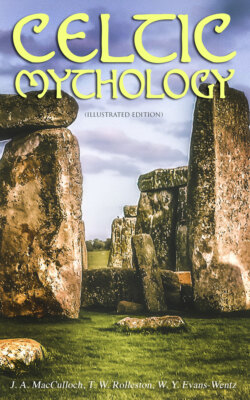Читать книгу CELTIC MYTHOLOGY (Illustrated Edition) - T. W. Rolleston - Страница 53
The Doctrine of Transmigration
ОглавлениеMany ancient writers assert that the Celtic idea of immortality embodied the Oriental conception of the transmigration of souls, and to account for this the hypothesis was invented that they had learned the doctrine from Pythagoras, who represented it in classical antiquity. Thus Cæsar: “The principal point of their (the Druids') teaching is that the soul does not perish, and that after death it passes from one body into another.” And Diodorus: “Among them the doctrine of Pythagoras prevails, according to which the souls of men are immortal, and after a fixed term recommence to live, taking upon themselves a new body.” Now traces of this doctrine certainly do appear in Irish legend. Thus the Irish chieftain, Mongan, who is an historical personage, and whose death is recorded about A.D. 625, is said to have made a wager as to the place of death of a king named Fothad, slain in a battle with the mythical hero Finn mac Cumhal in the third century. He proves his case by summoning to his aid a revenant from the Other-world, Keelta, who was the actual slayer of Fothad, and who describes correctly where the tomb is to be found and what were its contents. He begins his tale by saying to Mongan, “We were with thee,” and then, turning to the assembly, he continues: “We were with Finn, coming from Alba....” “Hush,” says Mongan, “it is wrong of thee to reveal a secret.” The secret is, of course, that Mongan was a reincarnation of Finn.33 But the evidence on the whole shows that the Celts did not hold this doctrine at all in the same way as Pythagoras and the Orientals did. Transmigration was not, with them, part of the order of things. It might happen, but in general it did not; the new body assumed by the dead clothed them in another, not in this world, and so far as we can learn from any ancient authority, there does not appear to have been any idea of moral retribution connected with this form of the future life. It was not so much an article of faith as an idea which haunted the imagination, and which, as Mongan's caution indicates, ought not to be brought into clear light.
However it may have been conceived, it is certain that the belief in immortality was the basis of Celtic Druidism.34 Caesar affirms this distinctly, and declares the doctrine to have been fostered by the Druids rather for the promotion of courage than for purely religious reasons. An intense Other-world faith, such as that held by the Celts, is certainly one of the mightiest of agencies in the hands of a priesthood who hold the keys of that world. Now Druidism existed in the British Islands, in Gaul, and, in fact, so far as we know, wherever there was a Celtic trace amid a population of dolmen-builders. There were Celts in Cisalpine Gaul, but there were no dolmens there, and there were no Druids.35 What is quite clear is that when the Celts got to Western Europe they found there a people with a powerful priesthood, a ritual, and imposing religious monuments; a people steeped in magic and mysticism and the cult of the Underworld. The inferences, as I read the facts, seem to be that Druidism in its essential features was imposed upon the imaginative and sensitive nature of the Celt—the Celt with his “extraordinary aptitude” for picking up ideas—by the earlier population of Western Europe, the Megalithic People, while, as held by these, it stands in some historical relation, which I am not able to pursue in further detail, with the religious culture of ancient Egypt. Much obscurity still broods over the question, and perhaps will always do so, but if these suggestions have anything in them, then the Megalithic People have been brought a step or two out of the atmosphere of uncanny mystery which has surrounded them, and they are shown to have played a very important part in the religious development of Western Europe, and in preparing that part of the world for the rapid extension of the special type of Christianity which took place in it. Bertrand, in his most interesting chapter on “L'Irlande Celtique,”36 points out that very soon after the conversion of Ireland to Christianity, we find the country covered with monasteries, whose complete organisation seems to indicate that they were really Druidic colleges transformed en masse. Cæsar has told us what these colleges were like in Gaul. They were very numerous. In spite of the severe study and discipline involved, crowds flocked into them for the sake of the power wielded by the Druidic order, and the civil immunities which its members of all grades enjoyed. Arts and sciences were studied there, and thousands of verses enshrining the teachings of Druidism were committed to memory. All this is very like what we know of Irish Druidism. Such an organisation would pass into Christianity of the type established in Ireland with very little difficulty. The belief in magical rites would survive—early Irish Christianity, as its copious hagiography plainly shows, was as steeped in magical ideas as ever was Druidic paganism. The belief in immortality would remain, as before, the cardinal doctrine of religion. Above all the supremacy of the sacerdotal order over the temporal power would remain unimpaired; it would still be true, as Dion Chrysostom said of the Druids, that “it is they who command, and kings on thrones of gold, dwelling in splendid palaces, are but their ministers, and the servants of their thought.”37
